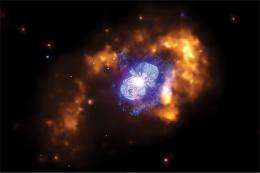11-Billion-Year-Old Giant Supernovae Farthest Ever Detected

(PhysOrg.com) -- UC Irvine cosmologists have found two supernovae farther away than any previously detected by using a new technique that could help find other dying stars at the edge of the universe.
This method has the potential to allow astronomers to study some of the very first supernovae and will advance the understanding of how galaxies form, how they change over time and how Earth came to be.
"When stars explode, they spew matter into space. Eventually, gravity collapses the matter into a new star, which could have planets such as Earth around it," said Jeff Cooke, McCue Postdoctoral Fellow in physics & astronomy, who reports his findings July 9 in the journal Nature.
The supernovae Cooke and colleagues found occurred 11 billion years ago. The next-farthest large supernova known occurred about 6 billion years ago.
A supernova occurs when a massive star (more than eight times the mass of the sun) dies in a powerful, bright explosion. Cooke studies larger stars (50 to 100 times the mass of the sun) that blow part of their mass into their surroundings before they die. When they finally explode, the nearby matter glows brightly for years.
Typically, cosmologists find supernovae by comparing pictures taken at different times of the same swath of sky and looking for changes. Any new light could indicate a supernova.
Cooke built upon this idea. He blended pictures taken over the course of a year, then compared them with image compilations from other years.
"If you stack all of those images into one big pile, then you can reach deeper and see fainter objects," Cooke said. "It's like in photography when you open the shutter for a long time. You'll collect more light with a longer exposure."
Doing this with images from the Canada-France-Hawaii Telescope in Hawaii, Cooke found four objects that appeared to be supernovae. He used a Keck telescope to look more closely at the spectrum of light each object emitted and confirmed they were indeed supernovae.
"The universe is about 13.7 billion years old, so really we are seeing some of the first stars ever formed," Cooke said.
Cooke and other scientists with UCI's Center for Cosmology last year discovered a cluster of galaxies in a very early stage of formation that occurred 11.4 billion years ago, the farthest of its kind ever detected. The galaxy proto-cluster, named LBG-2377, is giving cosmologists unprecedented insight into galaxy formation and the evolution of the universe.
Source: University of California - Irvine




















